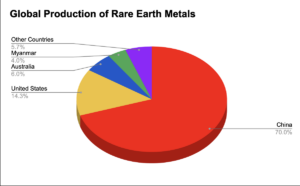Rare earth metals (REMs) are the backbone of the devices and innovations that define modern-day life. Every time you scroll on your phone, power up your laptop or charge most of your household electronics, you are tapping into a global trade network of REMs—a group of elements including cerium, lanthanum and neodymium that are essential to modern technology but come at an often-overlooked environmental cost. As more countries head toward sustainable energy alternatives, the demand for REMs is skyrocketing.
Found in everything requiring magnetic or haptic functions from phone batteries to military defense systems, these metals are powering the tech industry. Matching the increasing demand for high-tech and fuel-efficient innovations, the need for these elements rises substantially. LWHS chemistry teacher Richard Gibson stressed the importance of these earth metals in his workshop during the March 14 Teach-In Day, leading a class about REM mining and distribution in the global geopolitical scene.
Comprising of 17 chemically similar elements, REMs include 15 lanthanides, scandium and yttrium. Despite their name, not all are scarce. Gibson noted they are “rare” because isolating them requires intensive mining and complex processing.
Plus, the number of elements left to mine is dwindling. “In the case of some elements, [like Indium, Terbium and Hafnium] only certain amounts are still in the earth, and we’re set to run out in 50 to 100 years,” Gibson said.
Although REMs enable advances in sustainability—like lithium-ion batteries used in machinery such as wind turbines and electric vehicles—the extraction process of the rare earth industry is extremely environmentally taxing. The process has devastating effects, seen through catastrophes like the radioactive leak at Malaysia’s Bukit Merah site in 1982, and the toxic runoff from China’s Bayan Obo mine in 2020, one of the world’s largest operational rare earth element mines.
These crises fueled global concern about the environmental cost of REM extraction. Activists and scientists alike continue to denounce the poorly regulated extraction process and advocate for a global economy where recycling and reusing replace destructive practices.
As of 2024, around 70% of REMs are produced and refined in China. The U.S, reliant on imports for over 80% of its needs, has historically sourced from China. Trade tensions have sparked fears of China weaponizing its monopoly.
Even though more than 30 nations mine REMs, China has long controlled the market. This dominance was not a coincidence; China’s ascent was driven by aggressive state-backed investments, low labor costs and loose environmental regulations that made its production significantly less expensive than its rivals. As a result, other nations that were once leaders in the global REM market, like the U.S, closed the majority of their mines and became more reliant on Chinese exports.
However, there is a price for this reliance. Recent tensions with the U.S. have sparked fears that China could weaponize its rare earth monopoly again. In response, the U.S. has issued executive orders to boost domestic production and has looked to allies like Australia and Greenland for supply-chain alternatives.

The damaging extraction processes used in these REM mines are why so few other nations are properly equipped to refine and distribute massive quantities. The damaging processes of open-pit and in-situ leaching, the two main mining techniques, both produce hazardous waste as a byproduct. While in-situ leaching uses acidic solutions pumped underground to dissolve minerals, open-pit mining necessitates extensive earth removal and chemical processing which can leech toxic waste into the environment. Long-term chemical contamination and mass habitat loss often occur due to both these approaches.
Meanwhile, most consumers remain unaware. LWHS student Tyler Yee ’26 admitted, “I’ve never really thought about where the tech in my phone comes from.” But as Gibson said, “We’re becoming more and moreelectronically focused… so knowing what’s in our devices is important.”
REMs are vital for the future—but unless extraction processes are reformed, clean energy risks becoming another dirty industry. As innovation accelerates, so must efforts to ensure the solutions to our climate crisis don’t become another source of environmental harm.





+ There are no comments
Add yours